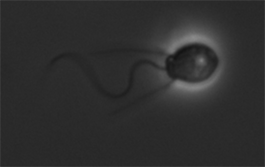
A new publication in the journal Nature has called into question a long-held hypothesis about the last common ancestor of animals. A group of single-celled (or colonial) protists called choanoflagellates are the closest living relatives of animals. Choanoflagellate cells have a whip-like flagellum surrounded by a basket-like structure that they use to capture and eat bacteria floating in sea water. Interestingly, these cells look and function very similar to feeding cells of sponges, one of the earliest-branching groups of animals. This has led to the hypothesis that the last common ancestor of animals looked like a choanoflagellate and that living choanoflagellates have retained ancestral characteristics present in the last common ancestor of animals. However, not much work has been done to test whether or not the similiar-looking cells of choanoflagellates and sponges are homologous. A team of researchers from the at University of Queensland in Brisbane, Australia and BSC’s Dr. Kevin Kocot compared the genes that are expressed or ‘turned on’ in choanoflagellate cells and different types of cells found in sponges. Surprisingly, the gene expression profile of sponge feeding cells is the least similar to the profile of choanoflagellates and is significantly enriched in genes unique to either animals or sponges alone. By contrast, sponge cells called archaeocytes, which express many of the same types of genes as stem cells of diverse other animals, were most similar to choanoflagellates. This suggests that the similar appearance of sponge feeding cells and choanoflagellates is due to convergent evolution and that the last common ancestor of animals probably had cells similar to stem cells that were capable of differentiation into multiple different cell types. Read more about this study study at UA News, UQ News, and Science Alert.